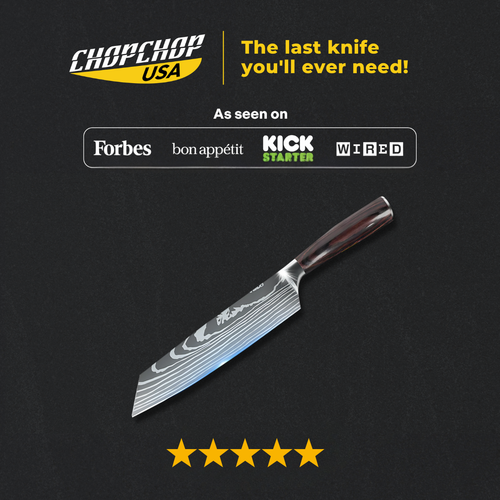How often should you replace kitchen items? The short answer: it depends on the material, usage, and care. Some tools last for decades, while others should be swapped out every few years—or even weeks—to maintain safety and performance.
In this guide, ChopChop USA highlights the average lifespan of essential cookware, utensils, and appliances, plus signs it’s time for a replacement. You’ll also find sustainable options like stainless steel and titanium that reduce waste and last longer. If you’ve ever wondered How often should you replace kitchen items, this guide gives you clear answers.
How Often Should You Replace Cookware?

Cookware is the foundation of every kitchen, and its lifespan depends heavily on the material. While some pans like stainless steel and cast iron can last decades, others like nonstick or ceramic need regular replacement. Knowing how often should you replace kitchen items in your cookware set ensures both safety and better cooking results.
How Often Should You Replace Stainless Steel Pans & Pots

Stainless steel cookware is known for durability and even heating, lasting 10–20+ years with proper care. These pans rarely need replacement unless they warp, develop deep scratches, or food begins sticking excessively.
For the best results, choose high-quality pans like the ChopChop USA Stainless Steel Frying Pan, designed to withstand everyday cooking and high-heat searing. A well-cared-for stainless steel pan isn’t just long-lasting—it’s a lifetime investment that grows better with time.
If you ask how often should you replace kitchen items, stainless steel is one you won’t replace often.
How Often Should You Replace Titanium Pans

Titanium Pan Pro is one of the most durable and lightweight options available, often lasting 20+ years. Unlike nonstick coatings that wear down, titanium’s natural strength makes it resistant to scratches, corrosion, and warping.
Some pans use a titanium-reinforced coating for nonstick convenience, but these should be replaced if the surface peels or chips. Investing in titanium pans means fewer replacements over time, making them both eco-friendly and cost-effective. Knowing how often should you replace kitchen items like titanium pans can save money and reduce waste.
How Often Should You Replace Carbon Steel Pans

Carbon steel is often called the “lighter cousin” of cast iron. With proper seasoning, it can last indefinitely. Over time, it builds a natural nonstick surface, making it ideal for frying, searing, and baking. Replace only if the pan cracks or rusts beyond repair.
Brands like ChopChop USA design Carbon Steel Pans with balanced weight and heat retention, ensuring professional-grade performance at home. Treat them right, and they’ll serve you for generations. Wondering how often should you replace kitchen items made of carbon steel? With care, almost never.
How Often Should You Replace Nonstick Frying Pans

Nonstick pans typically last 2–5 years depending on use and quality. Over time, coatings scratch, peel, or lose their nonstick properties. When food begins sticking or the surface looks worn, it’s time to replace.
The ChopChop USA Hybrid Nonstick Frying Pan is built with a reinforced surface that combines stainless steel durability with nonstick convenience—lasting longer than standard pans. Always use silicone or wooden utensils to avoid damaging the coating. For anyone wondering how often should you replace kitchen items like nonstick pans—the answer is every few years.
How Often Should You Replace Cast Iron Skillets

ChopChop USA Cast Iron Skillet is legendary for its longevity—often lasting for generations. With proper seasoning, a cast iron skillet becomes naturally nonstick and virtually indestructible. Replacement is only necessary if the pan cracks, which is extremely rare.
Many home chefs pass down cast iron as heirlooms, making it one of the most sustainable cookware options. It requires maintenance but rewards you with unmatched durability and versatility. If you’re asking how often should you replace kitchen items like cast iron, the truth is—almost never.
How Often Should You Replace Ceramic Cookware

Ceramic Frying Pans usually last 1–3 years. While they’re marketed as eco-friendly and nonstick, they tend to wear down faster than stainless steel or cast iron. Once the coating chips or food begins to stick, it’s time to replace.
They’re a good short-term solution for nonstick cooking, but less sustainable in the long run. That’s why when it comes to how often should you replace kitchen items, ceramic is on the shorter timeline.
How Often Should You Replace Kitchen Utensils

From spatulas to peelers, utensils get daily use and wear down faster than cookware. Knowing how often should you replace kitchen items like utensils helps keep cooking safe and hygienic.
How Often Should You Replace Wooden & Bamboo Utensils and Cutting Boards
Wooden and bamboo utensils, along with cutting boards, typically last 2–5 years. Over time, they can warp, crack, or absorb odors and bacteria. Bamboo is slightly more durable and less porous than regular wood, but both require frequent replacement for hygiene. Replace them if they show deep cuts or smell even after cleaning.
How Often Should You Replace Plastic Utensils and Cutting Boards
Plastic utensils and cutting boards usually last 1–2 years. They stain, scratch, and can harbor bacteria in grooves. Once warped, melted, or cracked, it’s best to replace them immediately. While inexpensive, they are less eco-friendly compared to longer-lasting alternatives.
How Often Should You Replace Stainless Steel Utensils and Cutting Boards

Stainless steel utensils and cutting boards are far more durable, lasting 5–10+ years. They resist stains, odors, and bacteria, making them one of the most hygienic options. The ChopChop USA Stainless Steel Cutting Board is designed to outlast wood and plastic, offering a sustainable solution for everyday chopping.
How Often Should You Replace Titanium Utensils and Cutting Boards

Titanium utensils and cutting boards represent the premium tier of durability. Lightweight, corrosion-resistant, and nearly indestructible, the ChopChop USA Titanium Cutting Board can last 10+ years. While more of an investment, titanium options are ideal for those seeking long-term, sustainable kitchen tools with unmatched strength
How Often Should You Replace Silicone & Metal Utensils

Silicone and stainless steel utensils can last 5–10 years or more. They resist heat, don’t warp easily, and are safer for nonstick cookware compared to metal. Replace them only if they become bent, cracked, or lose flexibility. Investing in a set of high-quality stainless steel tools ensures durability and reduces the need for frequent replacements.
Explore the ChopChop USA Pure Titanium Utensils and ChopChop USA Anti-Slip Silicone Mat.
How Often Should You Replace Peeler

A sharp peeler typically lasts 5–10 years. Over time, the blade dulls and becomes less effective, making peeling difficult and sometimes unsafe. Stainless steel peelers last longer than plastic-handled versions, especially when properly cared for. If the blade rusts, chips, or resists sharpening, it’s time for a new one. For longevity, invest in a sturdy, ergonomic stainless steel peeler from a trusted brand like ChopChop USA.
Explore the ChopChop USA Precision Peeler.
How Often Should You Replace Knives

High-quality knives can last 10+ years with proper maintenance. Regular sharpening is essential to keep them safe and effective. Replace knives only if the blade chips, corrodes, or no longer sharpens properly. Dull knives are more dangerous than sharp ones because they require more force, increasing the risk of slipping.
Investing in a durable chef’s knife ensures longevity and precision for everyday cooking. If you’re asking how often should you replace kitchen items like knives, the answer is: when sharpening no longer works.
Explore the ChopChop USA Knives Collection.
How Often Should You Replace Appliances

Appliances power daily cooking. Usage, care, and quality all affect lifespan. Knowing how often should you replace kitchen items in this category prevents frustration.
How Often Should You Replace Blenders & Food Processors
Blenders and food processors usually last 5–10 years. Signs it’s time to replace include weakened motors, dull blades, or inconsistent blending. Investing in a high-performance blender can extend its lifespan significantly.
How Often Should You Replace Microwaves
Microwaves typically last 7–10 years. Replace if heating becomes uneven, buttons fail, or the appliance shows rust or damage inside. Safety is the biggest factor here.
How Often Should You Replace Coffee Makers & Kettles
Coffee makers and kettles last about 3–5 years. Mineral buildup, leaks, or poor performance are signs it’s time to replace. Stainless steel kettles tend to outlast plastic versions.
For each, knowing how often should you replace kitchen items avoids wasted time and energy.
How Often Should You Replace Food Storage & Accessories

Storage items may seem small but impact hygiene. Wondering how often should you replace kitchen items like containers and sponges? More often than you think.
How Often Should You Replace Plastic Containers
Plastic containers usually last 1–2 years. They stain, warp, and can leach chemicals if damaged. Replace immediately if cracked or discolored.
How Often Should You Replace Glass Containers
Glass containers can last 5–10+ years if handled carefully. Replace only when chipped or cracked. They’re safer, longer-lasting, and more eco-friendly than plastic.
How Often Should You Replace Sponges & Dishcloths
Sponges should be replaced every 1–2 weeks, and dishcloths every 2–4 weeks. They quickly harbor bacteria and odors, making frequent replacement necessary for hygiene.
Conclusion
How often should you replace kitchen items? Some kitchen items—like stainless steel, titanium, and carbon steel cookware—can last decades, while others—like nonstick pans, peelers, and sponges—need frequent replacement. Investing in high-quality, durable tools from ChopChop USA ensures longer lifespans, better performance, and less waste. By knowing when to replace items, you’ll keep your kitchen safe, efficient, and sustainable.
For more amazing recipes, follow me on Facebook and Instagram! If you have any questions about ChopChop USA's products or promotions, please feel free to contact us at support@chopchopusa.com. Our dedicated team is available 24/7 and always happy to assist you.
Frequently Asked Questions
1. How often should I replace stainless steel pans?
With proper care, stainless steel pans can last 10–20+ years. Replace only if warped or severely scratched.
2. When should I replace nonstick pans?
Every 2–5 years, or sooner if the coating chips, peels, or food sticks regularly.
3. How often should knives be replaced?
Good knives last 10+ years. Replace only if the blade chips, corrodes, or can’t be sharpened effectively.
4. Do wooden utensils go bad?
Yes. Replace every 2–5 years or sooner if cracked, warped, or absorbing odors.
5. How often should I replace sponges and dishcloths?
Sponges: every 1–2 weeks. Dishcloths: every 2–4 weeks to prevent bacteria buildup.




